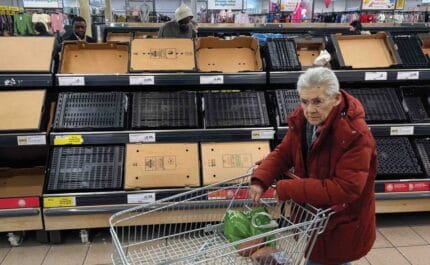The lion, the vets and the war zone – saving animals from Isis in Iraq and Syria
In April 2017 a band of animal lovers entered the besieged city of Mosul. Their mission: to save Lulu the bear and Simba the lion, the last two inhabitants of the city’s destroyed zoo. They faced Isis snipers, red tape and an Iraqi army general who wanted the animals dead. And then they tackled Syria… Marcus Webb tells the story of two incredible rescues
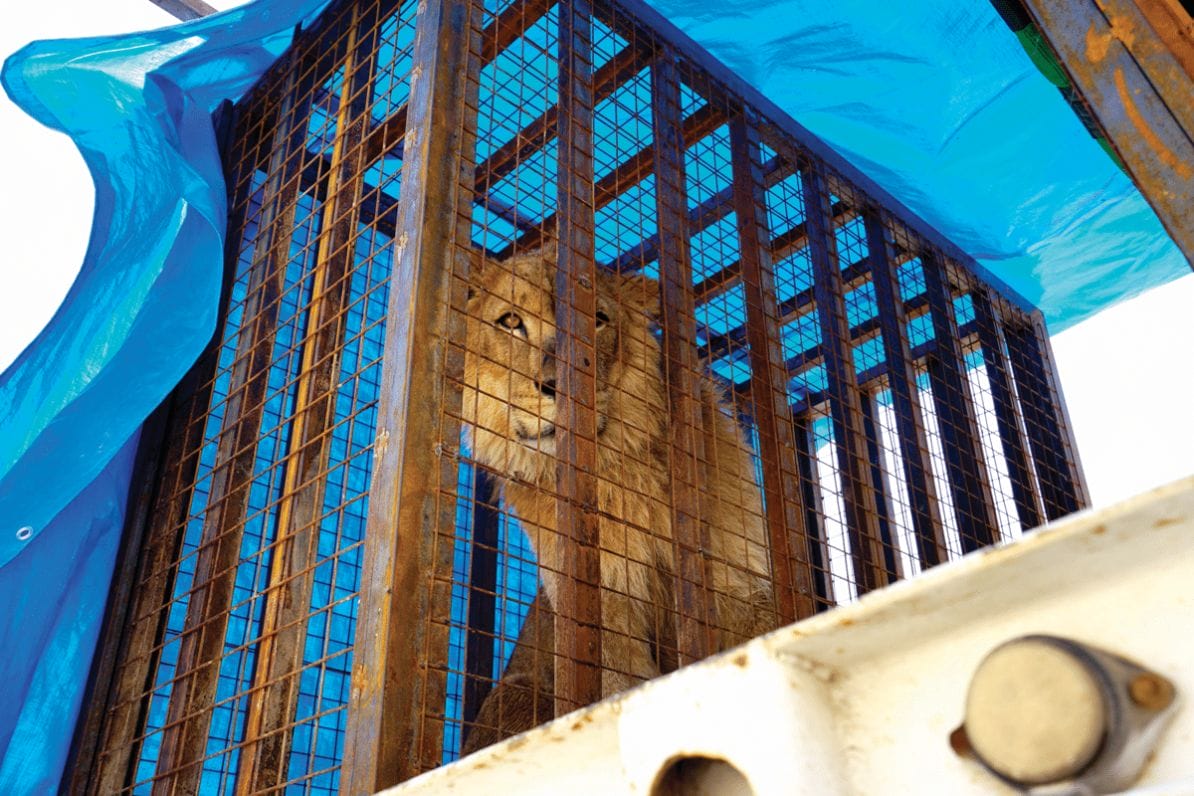
Photo: The Ocean Agency / XL Catlin Seaview Survey / Richard Vevers
10th April 2017 (Taken from: #27)
By the beginning of April the Battle for Mosul had raged for over five months and many more days of fighting lay ahead. Captured by Isis troops in June 2014, Mosul was to be the heartland of the caliphate in Iraq. After two years of brutal and repressive rule by the jihadists in the city, the Iraqi army was beginning to close in. By 16th October 2016 it had reached the outskirts of Mosul.
War soon raged on the city’s streets as Isis militants dug in, adopting guerrilla tactics to repel government forces. Allied bombing raids rained down high explosives. Up to 40,000 people lost their lives, over a million were displaced and at least 200,000 were trapped in the battered city, unable to escape the violence. But humans were not the only creatures caught up in the theatre of war…
Today Mosul’s Montazah Al-Morour Zoo is little more than a handful of rusty cages, but this privately owned menagerie was once home to more than 40 animals – including lions, monkeys and bears. When the fighting intensified in October 2016 the keepers were forced to abandon the zoo, leaving the caged animals to fend for themselves against starvation, bullets and bombs. By spring 2017 only two remained alive: a female Syrian brown bear named Lula, and Simba, a three-year-old lion.
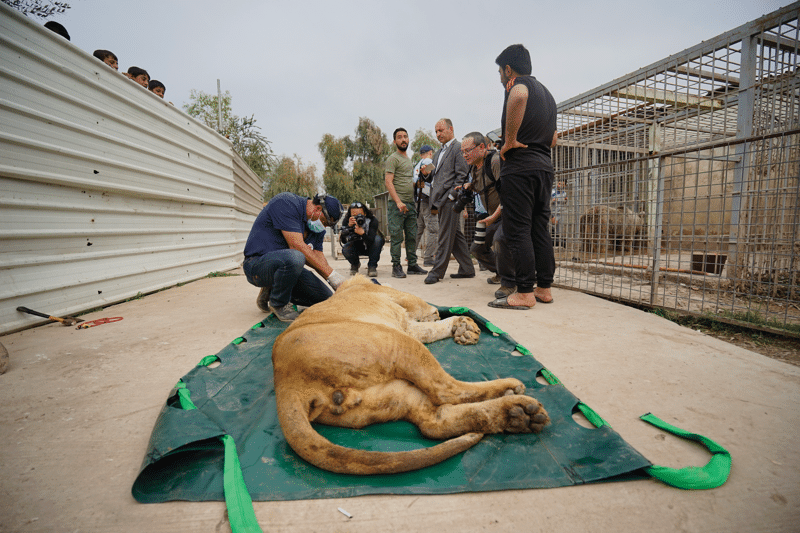
Dr Khalil examines Simba the lion in front of watching children, press and members of the Iraqi army. Photo: Four Paws International
Lula and Simba only survived thanks to the kindness of the residents of a city under siege. A handful of animal lovers in Mosul had been gathering together what little food they could spare, venturing out into a war zone, breaking into the zoo and throwing the scraps into the cages. But it was not enough. The animals’ health was deteriorating quickly and the residents took to Facebook to raise awareness of their situation. Their desperate messages reached Four Paws International, an Austria-based animal protection agency.
The organisation reacted quickly and on 22nd March its field vet Dr Amir Khalil entered Mosul. Part James Herriot, part John Rambo, Khalil is a kind of war vet veterinarian. The 52-year-old Egyptian has spent a quarter of a century saving animals from war zones on three continents. He has rescued tigers from “the world’s worst zoo” in the Gaza Strip and lions from one of Saddam Hussein’s former palaces in Baghdad after the 2003 war. However, nothing prepared him for what he saw in Mosul when he first arrived in March.
“The animals were in such a bad way,” says Khalil, barely able to contain his anger. “They were traumatised, they were malnourished and they would have died had it not been for the kindness of the people of Mosul. Their actions showed that there is humanity even in the darkest of times.”

Dr Amir Khalil and Four Paws volunteers carry Lula the bear through Mosul’s Montazah Al-Morour Zoo. Photo: Four Paws International
Khalil did what he could to stabilise Lula and Simba. He cleared out their cages, which were littered with debris, and gave them food and medicine. It quickly became clear that if the animals were to survive, they needed to leave Iraq. Having trained a handful of local volunteers how to care for the animals, Khalil returned to Vienna to make plans for their evacuation. “They were refugees,” he says of Lula and Simba. “It was our duty to give them sanctuary.”
Political animals
Khalil returned to Mosul within weeks with plans for a quick extraction operation. He was to be disappointed. Montazah Al-Morour Zoo lies on the eastern banks of the Tigris River, which in April separated the government-held part of the city from the remaining Isis territory. This watery red line was one of the most dangerous places in the Middle East, lined with Isis snipers looking to pick off Iraqi forces.
Convincing those in the crosshairs about the rights of two animals was not easy. “When we told soldiers why we were there, the initial response was usually ‘People are dying and you want the army to help rescue a bear?’ – but people change when they spend a minute standing next to an animal. I saw soldiers putting down their guns and bringing out their cameras for selfies. The same soldiers that had complained were soon splitting their rations with the bear. One confiscated two chickens from a truck and said, ‘Look, this is your lion’s meal.’”
But the power of big beasts cuts both ways. Khalil was aware that Lula, Simba and the team trying to rescue them would make valuable hostages for Isis. The operation was shrouded in secrecy, with the animals given codenames. “We called them ‘the vegetables’,” says Khalil with a laugh. These two vegetables needed to be handled carefully: both weighed over 200lb and were easily capable of mauling a person to death. To complicate matters further, they would need to be awake for the perilous journey from the zoo to the Iraqi border. Despite the weeks of food and medicine the animals were still dangerously weak and Khalil couldn’t risk sedating them.
We could hear explosions nearby, fighter planes overhead and all I could think was, please, please, please don’t let the lion roar”
On the evening of 31st March, the team, who had rehearsed everything in advance, moved the animals. It was one of the tensest nights Khalil can remember. “We knew there were Isis snipers,” says Khalil. “We could hear explosions nearby, fighter planes overhead and all I could think was, please, please, please don’t let the lion roar. One noise would sabotage all our plans, but it’s as if the animals knew – they didn’t make a sound.”
While the journey from the city was near silent, an uproar ensued when they arrived at the border. “The army generals at the border said we didn’t have the permission of the zoo owner to take the animals, that we were looting,” says Khalil. The team was forced to return to the zoo with their precious cargo.
We had to convince them that the lion and the bear were not members of Isis”
The Four Paws team eventually tracked down the zoo’s former owner in Kurdistan and – permission secured – started once again to move the animals to the border. Once more they were told they could not cross. “We needed security clearance,” says Khalil. “We had to convince them that the lion and the bear were not members of Isis.”
With Khalil reluctant to risk another trip to the zoo, a tense nine-day stand-off ensued as the team attempted to secure permission to pass. “There’s nothing at the border,” says Khalil. “There are no shops and we had to feed two hungry wild animals who don’t care how hard it is to get hold of food. We bought up all the meat in the nearest village within two days. Then all the meat in the next village two days later. We slept at the border for nine days; well, none of us actually really slept. War was not far away.”
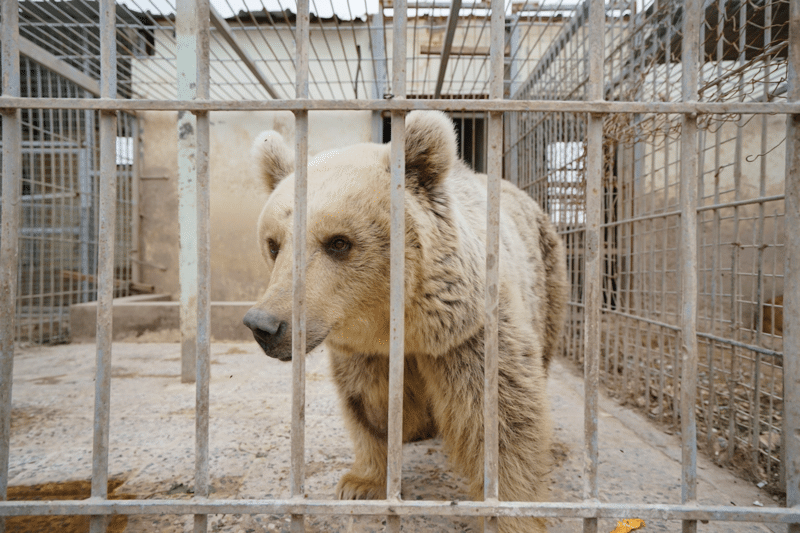
Photo: Four Paws International
With little sign of an end to the red tape, the team came under huge pressure. “A general in the Iraqi army – a man responsible for coordinating the missions in Mosul – gave me two bullets and a gun and said, ‘Go solve the problem,’” says Khalil. “I replied that if we shoot these animals then we are no better than Isis. We need to communicate that life, kindness and humanity cannot be divided.
A person should be kind to animals. A person should be kind to humans. If this humanity disappears then there is only darkness. Al-Qaeda, Isis, the rebels, the [Iraqi] army, the [allied] coalition – they kill people for territory, for beliefs, for revenge, for money, for carrying out orders… but it’s all because kindness and humanity have disappeared. These animals have no passports, no religion and no beliefs, but they were capable of something no human was: for a few days these animals stopped the war in Mosul. It felt like every general, every politician, had just one concern for those days: ‘What do we do with these animals?’”
Finally, on the tenth day, a breakthrough was achieved and Lula, Simba and the team were allowed to cross the border and board flights to the animals’ new home: the New Hope Centre, an animal sanctuary in Jordan. “The moment their paws touched the grass the lives of these animals were changed forever”, says Khalil. “We were proud of our achievement, but little did we know what was to come…”

Photo: Ahu Savan An
Mission impossible
Aalim al-Sahar (Magic World) was once one of Syria’s most visited zoos, but as the civil war took hold of the country in 2011, its owner fled. Six years later just 13 skeletal inhabitants remained – five lions, two tigers, two bears, two dogs and two hyenas. Hearing of Four Paws’ work in Mosul, the former owner contacted the charity and asked for help. “When we researched the situation in Syria it became clear that we’d had it easy in Iraq,” says Khalil. “All the security consultants we spoke to said it was impossible.”
Aalim al-Sahar is located on the outskirts of Aleppo. To the east were Syrian forces, to the south Isis, to the north and west territory controlled by various rebel groups and Al-Qaeda. Nobody on any side was interested in offering safe passage to a troupe of wild animals. Whereas Mosul had been a diplomatic drama, to get the animals out of Syria, Four Paws would have to stage something closer to a heist.
The team looked at lots of different scenarios. They couldn’t fly the animals out of Aleppo as government troops would never let a convoy travel to the airport from the rebel area. The road south to Jordan was too long and too dangerous. One plan even had tigers and lions being strapped into stretchers on the back of ambulances and driven across Syria.

One of the lions rescued from Syria arrives at the Al Ma’wa New Hope sanctuary in Jordan. Photo: Four Paws International
Working with Turkey’s Ministry of Forestry and Water Affairs, Four Paws came up with a scheme that might just work. “A van cannot drive from one territory to another,” explains Khalil. “Instead we found volunteers on all sides to drive as far as they could and then transfer the cages from one set of vehicles to another as they crossed into different regions.” The pass-the-parcel approach depended on people on different sides of the most bloody civil war of recent times cooperating to move the animals through rebel-, government- and Al Qaeda-held zones, before crossing into Turkey.
To provide some cover, Four Paws created a decoy convoy, openly discussing its route west when they thought they were being listened to, while secretly planning the real route out to the north. With no anaesthesia available the animals would, like Lula and Simba in Mosul, have to make the journey while conscious. Unable to get into Syria himself, Khalil had to direct the operations over phone and Skype.
The Russians didn’t know if it was animals or weapons in the trucks”
The teams navigated mines, troops on the ground and danger from above. “We were very aware of who controlled the airspace,” says Khalil. “The Russians didn’t know if it was animals or weapons in the trucks.” Amazingly the convoy snaked its way through the ten-hour, 180km trip to the Turkish border not once, but twice. They couldn’t accommodate all the animals in one trip, so having taken nine through on 21st July, they returned a week later for the four they’d left behind. “These people who volunteered to help are heroes and we can’t say their names,” says Khalil. “It would be too dangerous for them, but they know who they are and what they did.”
Once safely out of Syria, the animals were flown to Jordan where they joined Simba and Lula at the sanctuary. Soon the 13 became 14. “One of the lionesses, Dana, was pregnant the entire time,” says Khalil. “Within 12 hours of arriving in the sanctuary the cub was born. I like to think she was waiting until she was home.” The team named the cub Hajar – Arabic for ‘the emigrant’.
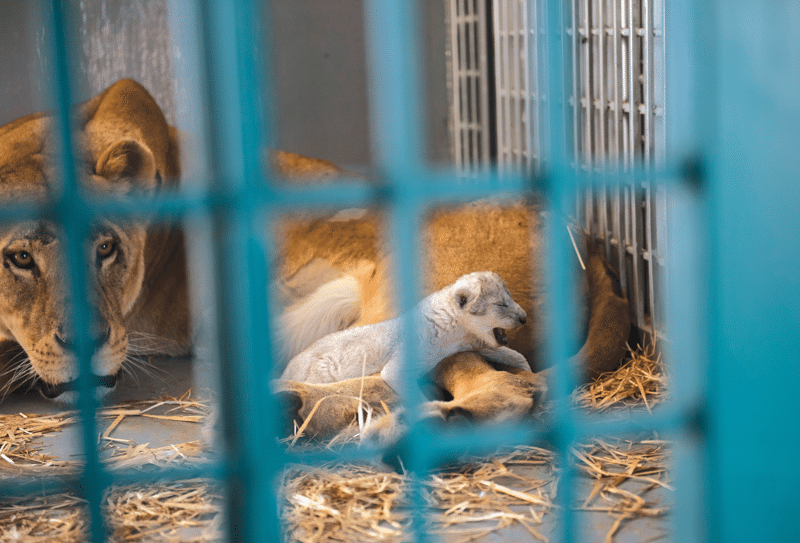
Lioness Dana with her newborn cub Hajar. Photo: Four Paws International
Two months later, the animals are making steady progress. “Within days we saw their health improving; now they are really strong,” says Khalil. “But the psychological healing will take longer. We need to give them space and time.”
Despite the risks to everyone involved, Khalil says he always believed the missions were worth it. “Animals can build bridges between nations,” he says. “In Gaza I saw Hamas and Israeli troops put their weapons down to help the animals. To see humanity even in the bleakest of times, it gives me some hope. It is good to remove the darkness and the hate – even if it is temporary. If we are not able to make people agree that each other’s lives matter, at least they can agree on the lives of these animals. We didn’t rescue these animals, we got them out, but I hope that they will eventually help to rescue us.”
Slow Journalism in your inbox, plus infographics, offers and more: sign up for the free DG newsletter. Sign me up
Thanks for signing up.


